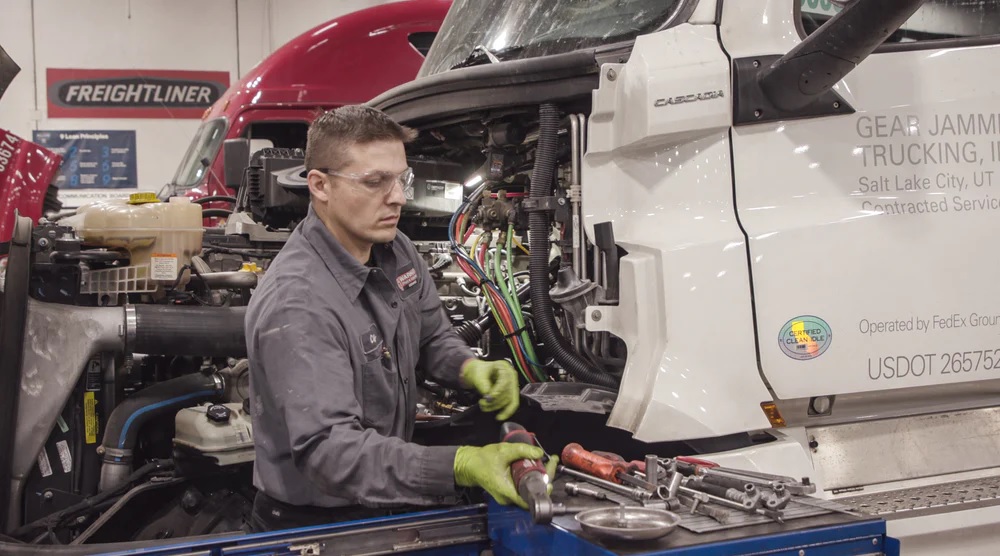As fleets begin their journey into the electric future, it is not too early to start thinking about the steps fleet owners need to take to make sure technicians are trained to work on these new vehicles.
When it comes to battery electric vehicles (BEVs) much of the talk centers around things like the cost of the truck, the charging infrastructure, battery range and weight, etc. But there is more to the electric vehicle discussion than that.
During Training #6 of NACFE’s Electric Truck Bootcamp, we assembled a panel of experts to talk about the maintenance and training needed for BEVs as well as to address safety issues that surround these high voltage vehicles.
According to Gary Lalonde, VP of North American truck sales at The Lion Electric Co., providing the right BEV training for maintenance staff and drivers is the fifth step in the five-steps to electrification. The other four being make sure electric vehicles fit your needs, consider total cost of ownership, discover all financing options, and get the right infrastructure evaluation.
BEVs will have a lot fewer moving parts than today’s diesel-powered trucks which should translate into less maintenance. There is speculation that maintaining BEVs will be less expensive, but it is too early to tell if that is true. And Lalonde says that 80% of the maintenance on BEVs will be done digitally and remotely.
Kevin Otto, chair of the Technology & Maintenance Council’s Electrified Vehicle Task Force and NACFE’s electrification technical lead, said fleets need to begin determining now what skills will be needed to diagnose and repair BEVs. He suggests fleets answer the following questions:
- How are BEVs different?
- What new skills do technicians need? What certifications?
- Where will they be able to get training?
- What tools will technicians need to work on BEVs?
- What kind of technical support will be available to technicians?
- What about training from the truck manufacturers?
The good news is that there already are training programs in place where technicians can get the skills needed to work on BEVs. John Frala, professor of alternative fuels as well as electric and fuel cell vehicles at Rio Hondo College, said work is already being done to create technician safety standards for BEVs.
Gregory Bowen, eMobility trainer and developer for Daimler Trucks North America, said that there is already an electrical safety standard in Germany. The HV1 level focuses on awareness and is geared toward drivers. HV2 focuses more on safety and is for technicians servicing all the low-voltage systems on the truck; HV3 focuses on high voltage and de-energizing the BEV.
In addition to ensuring that technicians have the new skills they need, don’t overlook the fact that BEVs will still have brakes, power steering systems and HVAC systems that will need to be serviced. But fleets also will need to make sure that they invest in things like insulated gloves and insulated tools for their technicians who will be servicing BEVs. Work must be done now to make sure technicians understand the proper safety procedures around high voltage cables, which are bright orange to make sure they are easily identifiable.
As fleets begin their journey into the electric future, it is not too early to start thinking about the steps you need to take to make sure your technicians are trained to work on these new vehicles. Start having conversations with the manufacturers of these BEVs to see what their plans are for helping you get your techs trained and begin a dialogue with your local technician training schools encouraging them to begin working on curriculum that cover BEV maintenance and repair with an emphasis on safety.
While BEVs may need less maintenance and repair, they are not maintenance-free. You’ll want to make sure your technicians are ready for them when they come rolling into your shop.
Michael Roeth has worked in the commercial vehicle industry for nearly 30 years, most recently as executive director of the North American Council for Freight Efficiency. He currently serves on the second National Academy of Sciences Committee on Technologies and Approaches for Reducing the Fuel Consumption of Medium and Heavy-Duty Vehicles and has held various positions in engineering, quality, sales and plant management with Navistar and Behr/Cummins.
Source: https://www.fleetowner.com/




